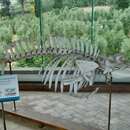External morphology
provided by EOL authors
Head Shape Melon is relatively flat and defined posteriorly by an indentation at the blowhole. The beak is thick and short with a massive lower jaw that rises prominently on either side of the rostrum about halfway along its length. The mouthline is strongly arched. Coloration Adult males are dark blue-black with a grayish saddle that extends posteriorly from just behind the blowhole for about half the length of the dorsum. The leading edge of the dorsal fin may also be gray. The snout and lower jaws are white or pale gray for up to half the length of the jaw or to just past the teeth. Some individuals have a whitish patch on either side of the forehead at the base of the rostrum. The throat grooves are white or pale gray and the flipper pocket is also lighter in color. Sexually mature males of this species often exhibit scarring from antagonistic sparring. Other oval scars, attributed to the cookie cutter shark, Isistius brasilensis, are present especially in the posterior ventral area of adults.Females have a slate gray dorsum with flanks and belly pale gray to white. There is less white on the beak than in males. Size Adult body length ranges between 3.9 to 4.9 m. Recorded maximum body length for adult males and females is 4.6 m and 4.9 m, respectively. Body length at birth is 2.2 m. Most Likely Confused With: Mesoplodon densirostris Mesoplodon ginkgodens
- license
- cc-by-3.0
- copyright
- Smithsonian National Museum of Natural History Marine Mammal Program
Skull morphology
provided by EOL authors
Diagnostic features of the skull and mandible On the vertex of the dorsal skull the premaxillary bone extends forward of the nasal and frontal. Separates from Berardius and Ziphius. A sulcus (groove) running along the middle of the combined surfaces of the nasal bones so depresses their middle that it is the lateral portion of each nasal bone that reaches farthest forward on the vertex. Separates from Tasmacetus and Indopacetus. When the skull is upright and the long axis of the anterior half of the beak is horizontal, a horizontal plane transecting the summit of either maxillary prominence transects the mesethmoid bone. Separates from Hyperoodon. Tooth alveoli of mandible overlap the mandibular symphysis. Separates from Berardius, Ziphius, Tasmacetus, Indopacetus, Hyperoodon, M. grayi, M. europaeus, M. hectori, M. mirus, M. perrini, M. densirostris, M. ginkgodens, M. peruvianus, and M. stejnegeri. Basirostral groove absent or present as a shallow groove that does not extend past the prominental notch. Separates from M. layardii. The maxillary prominences rise 15 mm higher than the height of the premaxillaries where the latter passes between the former. Separates from M. bidens. In dorsal view, the right premaxilla extends slightly posterior beyond the right nasal. Separates from M. traversii. Antorbital tubercle formed by the maxilla and frontal and is underlain by the jugal and frontal. Separates from M. carlhubbsi.
- license
- cc-by-3.0
- copyright
- Smithsonian National Museum of Natural History Marine Mammal Program
Stranding distribution
provided by EOL authors
Stranding Distribution Circumpolar distribution in the southern ocean waters north of the Antarctic convergence. Occurs in the southwest Pacific and Indian Ocean between 32oS and 54o30' S, and in the Atlantic Ocean between 36o and 52o S. The majority of recorded strandings have occurred in waters surrounding Australia and New Zealand.
- license
- cc-by-3.0
- copyright
- Smithsonian National Museum of Natural History Marine Mammal Program
Tooth morphology
provided by EOL authors
Tooth position A single pair of teeth is positioned midway between the apex of the beak and the posterior end of the mouth. Tooth exposure Erupted teeth in adult males are covered by gum tissue, with only the tip of tooth exposed. Teeth do not erupt in females or juveniles. Tooth shape In lateral profile, the anterior margin is weakly sinusoidal (convex proximally, concave distally) and is longer than the strongly convex posterior margin. A denticle is positioned at the top of the anterior edge of the tooth. When the denticle is not excessively worn, it extends well past the antero-dorsal edge of the tooth.
- license
- cc-by-3.0
- copyright
- Smithsonian National Museum of Natural History Marine Mammal Program

